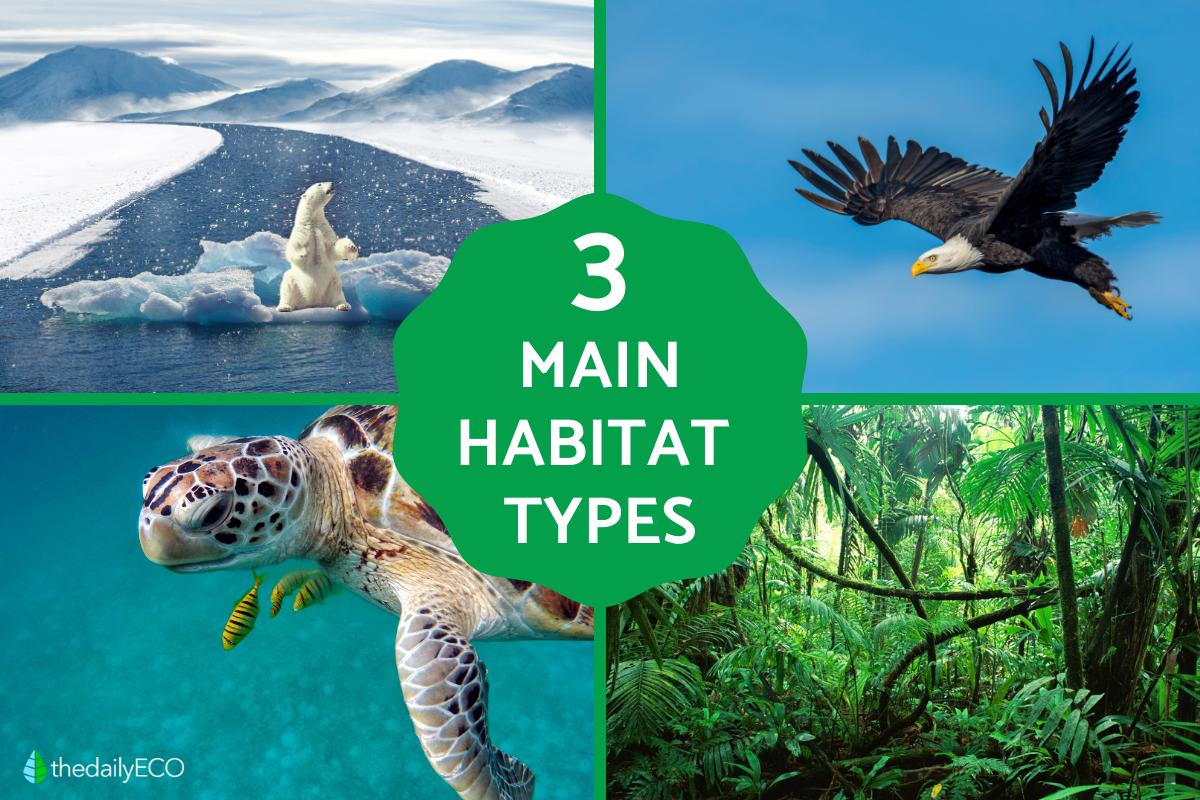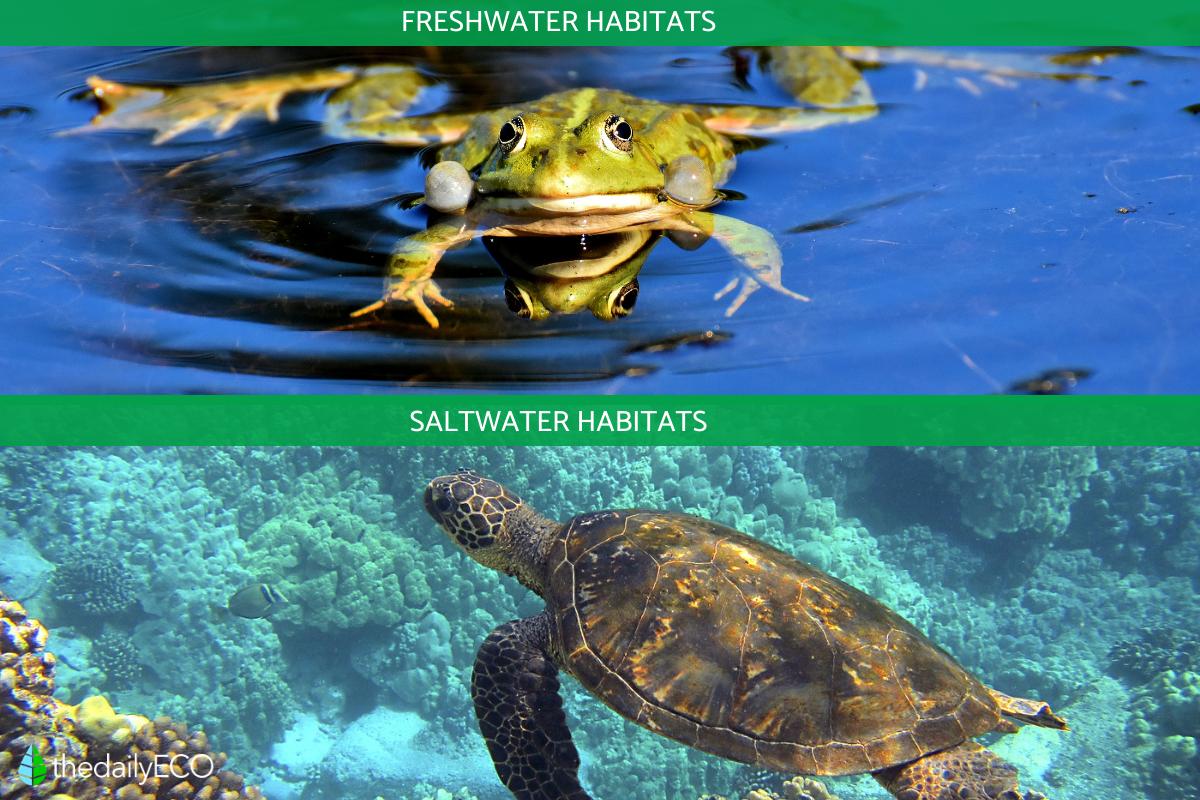What Are the 3 Types of Habitats?


Our planet thrives with life, a vibrant tapestry woven across diverse environments. From the sun-drenched stratosphere to the crushing depths of the ocean, a multitude of habitats provide the stage for this extraordinary biodiversity. While habitats seem infinitely varied, we can broadly classify them into three major types: aquatic, terrestrial, and aerial. Each type presents unique conditions and challenges, shaping the remarkable adaptations and evolution of the organisms that call it home.
In this article by thedailyECO, we'll delve into the three major habitat types – aquatic, terrestrial, and aerial – uncovering their defining characteristics and the fascinating life forms that have adapted to thrive within them.
What is a habitat
A habitat isn't just a location; it's a complex ecological unit. It's the natural environment where a species or a community of organisms lives and thrives. Think of it as a specialized niche within a larger ecosystem, like an apartment building designed for specific needs.
Habitats provide the essentials for survival and reproduction:
- Energy source: all living things need energy. Habitats offer plants, other organisms, or organic matter for them to consume.
- Water: this vital resource is essential for life. Habitats provide access to water through bodies of water, rain, or environmental moisture.
- Shelter: protection from predators, weather, and disturbances is crucial. Habitats offer burrows, dens, foliage cover, or the environment itself as shelter.
- Suitable conditions: temperature, sunlight, humidity, and other factors affect survival. Habitats provide the specific range these factors need.
Habitat size varies greatly. They can be microscopic, like the underside of a rock teeming with insects, or vast, like a rainforest with diverse communities.
Regardless of size, each habitat supports a unique assemblage of plants, animals, fungi, and microorganisms. These inhabitants have evolved adaptations to exploit resources and tolerate specific conditions. From forest floors to deserts, habitats are the building blocks of Earth's biodiversity.
What is the difference between habitat and ecosystem?
Habitat and ecosystem are often confused, but the key difference lies in scale and complexity. Imagine a habitat as an organism's "address" within a larger neighborhood. It's the specific environment, like a coral reef or a rotting log, that provides the resources a species needs to survive.
An ecosystem, on the other hand, encompasses the entire neighborhood, including all the habitats within it, along with the living things (biotic factors) and non-living aspects (abiotic factors) that interact and create a complex web of life. So, a coral reef ecosystem might contain multiple habitats, like the coral itself, the sandy bottom, and the open water above.
Terrestrial habitats
Terrestrial habitats encompass all land-based environments, forming a critical component of Earth's biosphere. These diverse ecosystems support a vast array of organisms, including plants, animals, fungi, and microorganisms.
Each habitat is characterized by specific abiotic factors like temperature, precipitation, and soil composition. These factors, along with biotic interactions, shape the unique communities found within each terrestrial environment.
Here's a breakdown of some major terrestrial habitat types:
- Forests: dominated by trees, forests are categorized further based on factors like temperature and rainfall. Tropical rainforests boast the highest biodiversity, while temperate forests and boreal forests exhibit adaptations to cooler climates. Forests play a crucial role in the global carbon cycle and provide habitat for a multitude of species.
- Grasslands: open plains dominated by grasses and other non-woody plants, grasslands are prevalent in regions with moderate rainfall. These ecosystems serve as vital grazing grounds for large herbivores, supporting food webs that include predators and scavengers.
- Deserts: arid regions with minimal rainfall and extreme temperatures, deserts showcase remarkable adaptations for survival. Plants like cacti store water efficiently, while animals like kangaroo rats extract moisture from their diet. Despite the harsh conditions, deserts support a surprising diversity of life, including reptiles, insects, and specialized plant communities.
- Tundras: treeless plains found in the Arctic and on mountaintops, tundras experience long, cold winters and short, cool summers. These harsh environments are dominated by low-lying plants like mosses and lichens. Well-adapted animals like caribou and arctic foxes can thrive in the cold. Tundras play a significant role in regulating Earth's climate by reflecting sunlight and storing carbon.
Terrestrial habitats are defined by land as the primary substrate, with varying moisture availability impacting plant and animal life. These land-based ecosystems experience wider temperature fluctuations and rely on atmospheric oxygen for respiration due to the differing gas composition compared to other habitats, like aquatic habitats.
Specific characteristics like soil properties, precipitation patterns, elevation, and topography further influence each habitat, shaping unique communities through factors like nutrient availability, sunlight exposure, and drainage patterns.
Land isn't all the same! Unveil the fascinating world of terrestrial biomes and their unique characteristics in another article on our webpage.

Aerial Habitats
Aerial habitats encompass the vast expanse of the atmosphere, from the layer we breathe near the Earth's surface to the high-altitude reaches.
Unlike terrestrial and aquatic habitats with a solid or liquid base, aerial habitats are defined by air as the primary medium. This offers a buoyant environment for organisms adapted to flight or gliding.Organisms living in aerial habitats face unique challenges like strong winds, turbulence, and limited resources. Adaptations for flight, efficient oxygen use, and thermoregulation are essential for survival in this environment.
Conditions within aerial habitats change significantly with altitude. Temperature generally decreases with increasing altitude, while air pressure and oxygen availability also decline.
The aerial environment is home to a variety of organisms, each with adaptations suited to life in this gaseous medium. Birds, the most prominent inhabitants, exhibit diverse beak structures for specialized feeding strategies. Many insects, like butterflies, bees, and dragonflies, rely on wings for navigating air currents. Bats, the only true flying mammals, excel in aerial locomotion and hunting using echolocation. Other animals, such as gliding squirrels and flying lizards, utilize anatomical features to extend their mobility within the aerial habitat. Even microscopic organisms like bacteria and fungi can be passively transported by air currents, demonstrating the interconnectedness between aerial and terrestrial ecosystems.
Aerial habitats lack formal subcategories like terrestrial or aquatic ones due to their less structured nature.
Aerial habitats play a crucial role in Earth's ecosystem. They facilitate the movement and dispersal of organisms, including pollination by insects and seed dispersal by wind. Additionally, the atmosphere regulates Earth's temperature and protects it from harmful solar radiation. Understanding and protecting aerial habitats is vital for maintaining the health of our planet's ecosystems.
Beyond breathing, air plays a crucial role in our world. Unveil the wonders of air and its life sustaining properties in another article on our webpage.

Aquatic habitat
Aquatic habitats encompass the vast realm of freshwater and saltwater environments. Unlike land-based habitats, aquatic environments are defined by the physical and chemical properties of water, shaping unique ecological niches for their inhabitants. Water, being the primary medium, affects all from movement, respiration, to available oxygen. Salinity levels and water pressure also vary within aquatic habitats, influencing the communities that thrive there.
While less extreme than land, temperature variations in aquatic habitats influence species distribution and adaptations. It is also important to note that light levels decrease with depth, creating distinct zones. The shallow photic zone allows photosynthesis by plants, while the deeper aphotic zone relies on chemosynthesis.
Aquatic habitats fall into two main categories:
Freshwater habitats
These habitats encompass all water bodies with a low salt content, typically less than 1%. They experience varying degrees of water flow, ranging from still lakes and ponds to fast-moving rivers and streams. Examples include lakes, rivers, streams, ponds, wetlands (marshes, swamps, bogs)
Freshwater habitats teem with life, from fish specifically adapted to these environments to amphibians like frogs and salamanders. Aquatic insects like dragonflies and mayflies flit across the surface, while mollusks like mussels and clams thrive on the bottom. Crustaceans such as crayfish and shrimp add to the diversity. These inhabitants share crucial adaptations for survival: maintaining buoyancy, extracting oxygen dissolved in water, and tolerating the fluctuations in freshwater temperatures.
Saltwater habitats
These habitats encompass all water bodies with a high salt content, typically exceeding 3%. They include the vast oceans and seas, as well as coastal areas where freshwater mixes with saltwater, creating estuaries. Examples include oceans, seas, estuaries, coral reefs
Saltwater habitats also encompass a vast array of life forms. Marine mammals including whales, dolphins, and seals are prominent inhabitants. Fish possess adaptations for surviving high pressure and salinity alongside diverse invertebrates like squid, octopus, and crabs. These environments also support a variety of marine plants, such as kelp forests and seagrasses. Adaptations in saltwater organisms are crucial for survival: specialized organs regulate salt balance, gills efficiently extract oxygen from water, and robust bodies withstand the immense pressure of deep ocean depths.
Aquatic habitats are vital because they regulate Earth's climate, influence weather patterns, and provide essential resources. They are a source of food, medicine, and cultural significance. However, pollution, overfishing, and climate change threaten their health.
Beyond the surface lies a fascinating world. Unveil the underwater world and its unique aquatic ecosystems in another article on our webpage.

If you want to read similar articles to What Are the 3 Types of Habitats?, we recommend you visit our Ecosystems category.
- National Geographic. (2010). Monarch butterfly . Available at: https://www.nationalgeographic.es/animales/mariposa-monarca
- Whiteman, L. (2000). Bar-headed geese migrate over Mount Everest, where oxygen is scarce and life is rare. How do they survive in such conditions? "The High Life." Audubon 102 (6): 104-108. Available at: https://web.archive.org/web/20140209231019/http://archive.audubonmagazine.org/birds/birds0011.html
- Secretariat of Environment and Natural Resources of Mexico. (2021). Sahuaro, key species in the Sonoran desert ecosystem . Available at https://www.gob.mx/semarnat/es/articulos/sahuaro-epecie-clave-en-el-ecosistema-desertico-de-sonora?idiom=es








